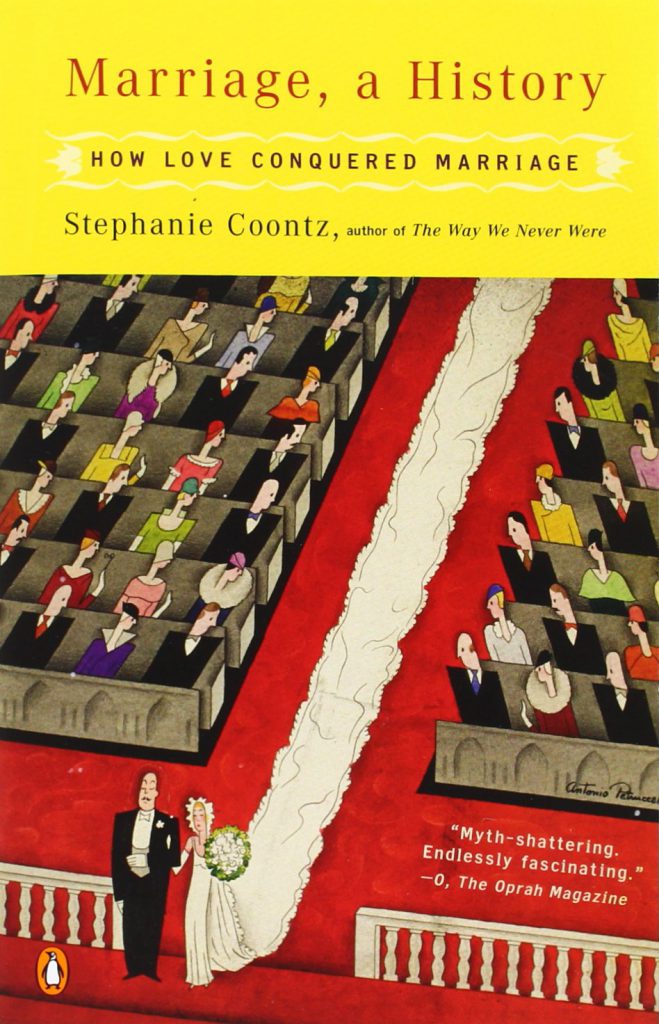 Marriage, A History by Stephanie Coontz is not a book about wedding ceremonies.
Marriage, A History by Stephanie Coontz is not a book about wedding ceremonies.
But, I found the book fascinating nonetheless. Since reading it, Fox News seem sillier than ever. It also challenged assumptions I didn’t know I have about the complementary natures of people rather than men and women.
In the years leading up to writing the book, Coontz was interested in the frenzy about our nations “marriage in crisis” that seemed to assume some kind of “golden age” of marriage. It was her belief that the golden age never existed. Through her years of study on the topic, she found that she was wrong. There had been a “golden age” of marriage, as some assert. It lasted about 15 years.
In The Book
The book is broken up into four parts, each covering a major ‘era’ for marriage–relative, of course, to the information we have about it. The first two parts were about marriage prior to about 1600-1700. Worldwide, in humanity’s earliest cultures with records of such things had a broad and nuanced set of expressions for marriage. Very little existed like what some might call a “traditional marriage”, that is, a man and a woman, where the man is the sole provider.
It was usually a man and a woman. But sometimes it was a man and a dozen women. Or a woman and a dozen men. Or it might have been a man, and a woman, and a dozen men. Some of these traditions lasted longer than our culture has even been around. You don’t find anyone challenging the legitimacy of those marriages today.
Regardless of the exact expression, marriage was not about love. In fact the very idea was scorned and in some cases, considered madness. Not just by elites, but every day folk. Instead, marriage was practical. It was the chief economic mechanism. Alliances were secured with a marriage. Communities relied on it to pool investments. It was the mechanism used to ascertain and maintain power and rule. Marriage between men and women also represented an important spectrum of abilities. While men hunted, women would do the domestic duties. They were more crucial at the time. Without them, you would probably die. Men and women needed each other to survive.
So by regulating marriage, cultures throughout the ages have shaped the way inheritance is passed down, how legitimacy is determined how power is given and who does what. That is up until about the victorian era.
In part three, Coontz comes into the 1700 and 1800’s, where the climate had begun to shift. A series of improvements to women’s rights, and blows to laws about divorce had more people wanting to be in love. Though most still thought the idea of marrying for love was impractical. Sometimes ‘Lords’ would marry a series of women for practical reasons, then finally, marry one he really “loved”. I’m not sure what that means, but I’m guessing it’s not romantic picnics by the seaside.
Women were also more strongly exercising what rights they had to refuse marriage, and more and more often, they were accepting the proposals of those they “loved”, instead of those purely for economic gain. Key female figures throughout history made and lost gains in pursuit of equality, but the result was an ever gradual reduction on two of marriage’s common distinctions: child bearing and for-better-for-worse commitment.
The final chapters in part four bring us into the modern day. By the early 1970’s de facto no-fault divorce was available to most people. Some couples were choosing not to have children. Or not to marry, or to marry late. By this time, that “golden age” of marriage, had passed. That time people refer to when they refer to ‘traditional marriage’ lasted just a brief 15-ish years around 1950 in the US and 1960 in Western Europe.
After the riots at the Stonewall Inn, and the bold feminist statements just a few years earlier, marriage was about to become a lot more nebulous.
“It was heterosexuals who had already created many alternative structures for organizing sexual relationships or raising children and broken down the primacy of two-parent families based on a strict division of labor between men and women.”
The institution of marriage might indeed be in crisis. But the institution is no longer the critical fixture it once was. “Marriage is more fragile, but when it sustains, it is more fulfilling”.
My Take Away
I began reading this book in an effort to more completely understand the ceremonies I photograph. I’ll admit, what I wanted was the history of weddings, not marriage. But, I’m glad I spent the time anyway. What I found reinforces my existing beliefs about marriage–that it’s evolutionary. There hasn’t been any one truly ‘traditional’ marriage. The Na people around 1300-1600, for example, had non-sexual marriages between brothers and sisters. Sexual activity that produced children was essentially done through sanctioned one-night-stands between different sibling groups.
The changes in marriage don’t pose a threat to society or people. And, unless you can only define marriage by a brief period on the 50’s, they don’t pose a threat to the institution either. Marriage is constantly changing and evolving, crisis is just what it looks like from the inside.
What we once did for practicality, we now do for pleasure and that’s alright with me.

Recent Discussion